MCCORRY'S MEMOIRS
Era 1: A Pre-Schooler in a Sheltered Cage (1966-72)
Written by
Kevin McCorry

And let there be light! Kevin McCorry has arrived in the world. A photograph of me in my bedroom in 1968.
The saga of my life opened in a hospital in Rivers, Manitoba, in central Canada on a frigid January 5, 1966. I have been told that I was overdue by a few weeks. Apparently, I, the first and only son and the first and only child of Mr. and Mrs. Edward McCorry, was in no hurry to come into the world!
My birth was in a week when Simon and Garfunkel's "The Sound of Silence" was top of the popular music charts, and it was in a banner year for television, the year in which television networks in the U.S. and Canada made the leap to offering a full roster of colour television programming. I cannot overstate the importance of colour, vivid, lavish colour, in the appeal of television and the imaginative creations thereon, to me, in my formative years. Also, as is known to any aficionado of science fiction/fantasy, 1966 was the year wherein Star Trek had its television debut. Yes, Star Trek's presence on television and I share the same year of birth. But I would not set eyes upon Star Trek until I was deep into my juvenile years, long, long after its removal from U.S. network television, and Star Trek would not be my outer space opus of first choice.
1966 is also often considered to be the first year of the age bracket known as Generation X. I certainly think of myself of being of that generation, and not of the post-World War II Baby Boomer generation that preceded it.
I would note also that when I was born, the highest grossing movie in theatres was the fourth James Bond movie, Thunderball. Thunderball, whose producer, and one of whose writers, was one Kevin McClory. Some people have spoken of the similarity of my name with his, with some amusement. That I was born during the circulation in theatres of a work of a Mr. McClory, and one that I enjoy as an enthusiast of the James Bond films, can elicit a lighthearted smile from me, if I am in the right humour for that.
Kevin was a popular name for babies born in the late 1960s, and my parents thought that its Scottish origins befitted the McCorry surname, which has a Scottish and Irish history. My father was born and raised in Nova Scotia, or New Scotland, Canada, where many McCorrys settled in the 1800s.
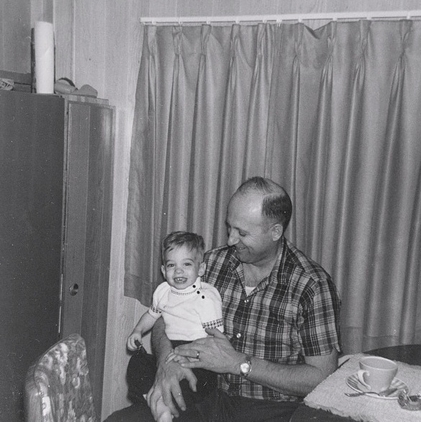
My father and I in our home in Rivers, Manitoba, Canada in one of my earliest years of life.
The combination of Kevin with McCorry may seem so rare as to be unique, but I have learned that there are at least five other Kevin McCorrys in the world. In Britain and in the U.S.. At this juncture, it seems that I can claim uniqueness as the only Canadian Kevin McCorry. I often wish that I had a more common last name! Constantly having to spell McCorry for people and seeing it misspelled as McCorey, McCory, McCurry, McQuarrie, McCarry, Corey, and, of course, McCoy, can be quite a tiresome ritual.
No one has ever misspelled it as McClory, however.
My mother was one of four children. Her older sister gave birth to five children. Her older brother fathered three children, and her younger brother was parent to two. So, as an only-child, in my mother's extended family, I was an anomaly. An oddball. Also, with but one exception, my cousins were older than I. The one exception, who is one year my junior, has lived in the southwestern U.S. for nearly all of my life. I have only met him twice, both of those times in adulthood. Though I was not the youngest in my mother's extended family, I was considered to be the "baby" in it. I certainly saw myself as that. And when my cousins were together talking at the occasional, the very occasional, extended family gathering, I seldom ever "fit into" the conversation. I usually never even made the attempt to do so, opting instead to keep to myself and concentrate my attention upon something of interest to me. But if I were to endeavour to contribute a sentence or two, usually I would be either ignored completely or given as brief a response as possible. Oh, I had one or two times of comradeship with my cousins, when they, as I, were on the juvenile side of puberty, and we were viewing some television television show of a shared interest. But by the mid-to-late-1970s, my cousins and I were not compatible company. They certainly preferred each other, and I kept to myself.
My father's family background is obscure. He and his brother were separated at an early age and were both raised in foster homes. Why, I do not know. And after their separation, they never again had any communication with each other. I met my paternal grandmother only once, and that was in the 1980s, not long before she died. My father told me very little about her. I know nothing about my paternal grandfather. If I have any extended family from my father's brother, I do not know it.
1961 was the year of my parents' wedding. Sometime thereafter, my father, who was in the Canadian military and had been therein since the Korean War in which he served his country but did not see combat, was posted to Europe, to Germany, and he and my mother lived there for a couple of years. My mother had recently completed training in nursing. While in Germany, they saw the James Bond movies, Dr. No and Goldfinger.

An assemblage of pictures of some of the phenomena of my earliest years on Earth.
When I was born, my mother was twenty-nine years-old, and my father was in his thirty-seventh year of age. My mother was a career woman, who opted to defer childbirth until her late twenties. I do not know why my father did not marry until he was in his thirties. The fact was, that my parents were of an older age than were those of most of my friends over the course of my life. And my mother's decision not to raise a family until she was nearly thirty increased the likelihood of me being sibling-less. And she was also a heavy smoker, which might have shortened her time frame of fertility.
After their time in Germany, my parents moved to Rivers, Manitoba, Canada, and bought a mobile home there. For them to have seen Goldfinger in Germany, they would have had to be there close to Christmas in 1964, or in early 1965. I may have been conceived in Germany, or shortly after my mother and father's return to Canada. I cannot say for sure either way.
Rivers was the site of a Canadian Forces (i.e. Canadian military) Base. It was where my father was posted in the mid-1960s after his and my mother's return to Canada from Germany. My father, having been promoted to Lance Corporal, would work in an administrative capacity, sometimes also operating and/or repairing machinery, for the remainder of his years in Canada's military. My mother would work as a Registered Nurse (R.N.) at Rivers Hospital before joining the Victorian Order of Nurses (V.O.N.).
Rivers was a small town in western Manitoba, and, like most places in the Canadian prairies, it was built on totally flat land with plenty of open space in the yards along its streets. And on its horizons were vast vistas with sparse tree growth. The Canadian Forces Base in Rivers was that Manitoban town's dominating economic and infrastructural element. It would be decommissioned in 1971.
We lived in our mobile home in a Rivers trailer park, and went to the nearby Manitoban city of Brandon on frequent shopping excursions. I have vague memories of eating Kentucky Fried Chicken in Brandon.
As is true for most people, my toddler years are not very clearly remembered, though I can recall attaining my first footsteps, riding a plastic car and being reluctant to progress to a tricycle, and spelling words like interlude with my letter blocks. I also accompanied my father to the Rivers Post Office. I have some flashes of memory of that. Each person's mail there was in a tiny locked compartment in a wall, and I remember my father extracting envelopes from the compartment allocated to him. I was, I can recall, rather impressed by the appearance and procedures of the Post Office. And, too, by the idea of printed matter. I was learning to spell, and I was in awe at how words were formed as visual objects, and at the importance of them in the world around me.
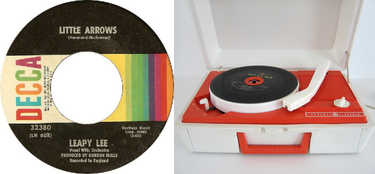
Image left is of the label of the vinyl record of Leapy Lee's rendition of the song, "Little Arrows". A vinyl record which was possessed by me in early childhood. And image right is of the children's phonograph machine on which I listened to my "LITTLE ARROWS" vinyl record over and over and over again.
I was also impressed by recorded media: non-live television, vinyl records, and reel-to-reel audiotape. So impressed was I with the latter of these that I would unravel my parents' audiotapes! Among the musical pieces that I enjoyed were "Little Arrows", sung by Leapy Lee, and Henry Mancini's "Baby Elephant Walk". I played my "LITTLE ARROWS" vinyl record on my children's phonograph so many times that the little vinyl record player's needle reduced the vinyl grooves to nothingness! Later musical fancies included Beethoven's Ninth Symphony and HERB ALPERT'S GREATEST HITS, a curious mix of moody symphonic melodies and Southern U.S. jazz. For my birthday party in 1974 during Era 2, I played an 8-track audiotape of Herb Alpert music (I had HERB ALPERT'S GREATEST HITS on audiotape in addition to vinyl platter) as I and my cohorts in revelry were eating chocolate birthday cupcakes and my mother was snapshooting a series of instant photographs of our festivities.
The label to the "LITTLE ARROWS" vinyl record sported the vinyl record's production company, Decca, in uppercase lettering, each letter having a different colour. I was already impressed at the print of the letters, their font and their size on the label, and the colours in their selection and their lavishness had me captivated. I adored rich colours, especially when they were in combination. There was also an arrangement of multiple colours on the label analogous to that from a spectroscope. I loved it.
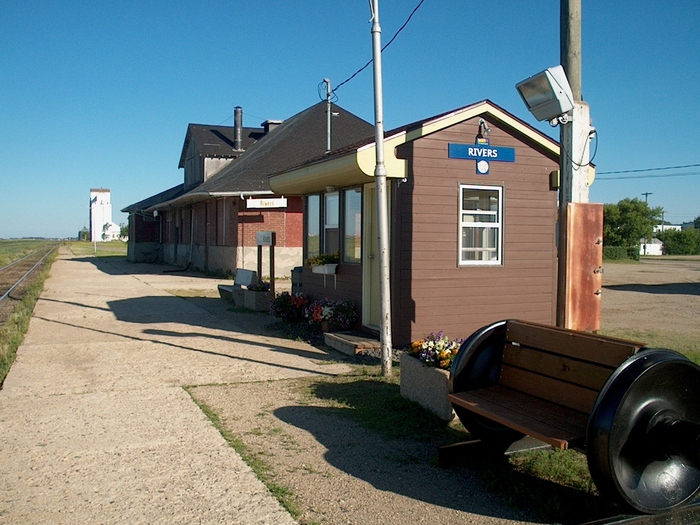
Rivers, Manitoba, Canada's train station. Passenger trains would come through the Rivers train station while en route to places east and west of the Manitoba town, Rivers, in which I was born and where I lived for my life's first four years. My parents and I would step aboard or step off of trains at the Rivers station for our travels to or from Canada's province of New Brunswick from where my mother hailed.
My mother's parents, the Smallwoods (no relation to Newfoundland's famous Premier), lived in Fredericton, New Brunswick, in Canada's eastern Maritimes, and my mother, father, and I often travelled from Manitoba to New Brunswick by train. Rivers had its own railway station, at which we boarded eastbound passenger trains and disembarked the trains that brought us back to Rivers.
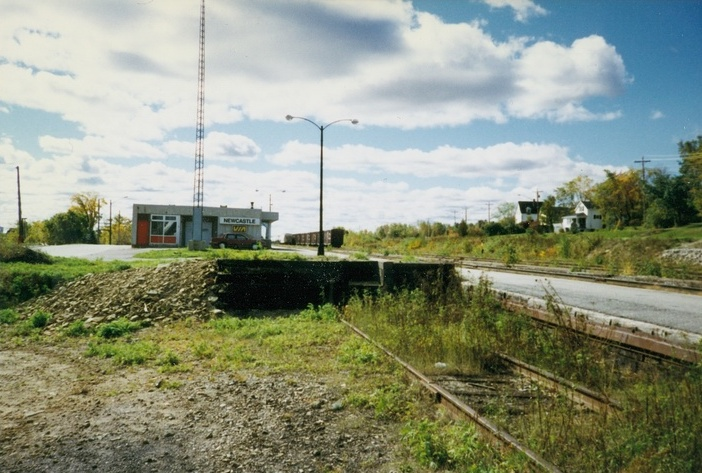
The train depot in Newcastle, New Brunswick, Canada, at which I boarded and disembarked several passenger trains during my pre-school years. Photographed in September, 1996.
Going eastward from Manitoba to New Brunswick, passenger rail lines in Canada ran through the provinces of Ontario and Quebec and entered New Brunswick by that province's northern and western frontiers. One of the passenger rail lines then went from Campbellton, the northernmost New Brunswick municipality, through the largest townships of the Miramichi River region of New Brunswick, and proceeding toward to the city of Moncton on New Brunswick east coast. My grandparents would collect us at the train depot in the town of Newcastle and convey us to their place in Fredericton, and return us to the same train station for our journey back to Manitoba. My mother and I stayed in Montreal, Quebec with a friend of hers for a day or two while we were going east from Manitoba to New Brunswick on one of our railway travels, and my only memory of being in my mother's friend's apartment is of eating Dare French Creme cookies for breakfast.

1970s picture of a C.N. passenger train at Newcastle train depot.
Train. I was fascinated by this mode of transport. The exterior and interior appearance, the atmosphere (including the smell of the engines), the private berths and the bunk beds and tiny cakes of soap, and the restaurant cars of the trains belonging to C.N., Canada's passenger rail company, fostered a childhood love for riding the rails. One of the first things that I aspired to be was a train engineer. On one Christmas in my pre-school years (the Christmas of 1971, I believe), I asked for and received an electric train set. And the locomotive for that train set had the distinctive look (red front and diagonal white stripes on sides) of C.N.'s locomotives.
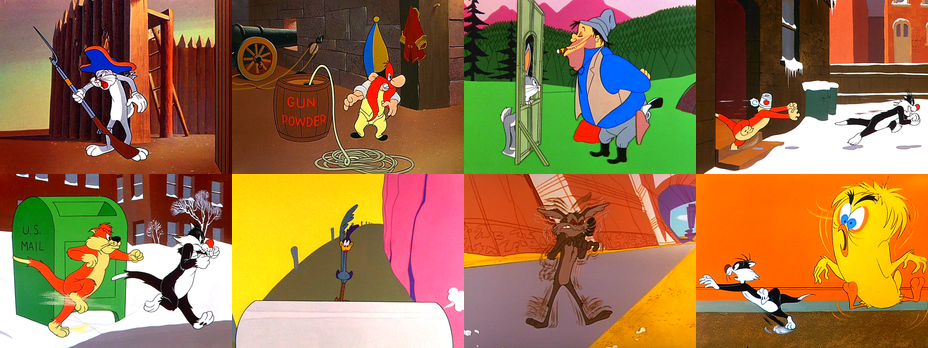
A collection of images of cartoons in episodes of The Bugs Bunny/Road Runner Hour memorably seen by me in my earliest life era. In places where I lived in my first years of life, The Bugs Bunny/Road Runner Hour was the principal avenue of presentation on television for Warner Brothers cartoons.
Alas, the electric train set did not stay operational for very long. But within that frame of time in which the train set was in working order, I played with it while such television shows as The Dick Van Dyke Show and The Beverly Hillbillies were being watched by my parents. However, when the Warner Brothers cartoons were shown on television, mainly via their principal avenue of presentation, i.e. The Bugs Bunny/Road Runner Hour, in my places of habitation, no toy would distract me from the gorgeously colourful televisual images. Watching reconstructions of Bugs Bunny/Road Runner Hour instalments tends to be evocative of memories of my early childhood such as several of those mentioned here in my first life era memoirs, in addition to accentuating recall of many formative times in my age 7 to 9 time period in Era 2 from 1973 to 1975, during which the Saturday broadcasts of Bugs and the Road Runner constituted my most anticipated event of each week.
Because I was their only offspring, my parents were more protective of me than were parents of children of one or more siblings, and since I was rather sheltered in this life era from the rambunctious conduct of other youngsters of our neighbourhood, I was more naive and sensitive than they, a fact that my mother and father may have perceived and which prompted them to shield me further from the big, bad world outside of our cosy mobile home. A home which, by its name, implied movement from community to community. And this we did, a number of times, which was another reason why I had no friendships of note in my earliest years on Earth.
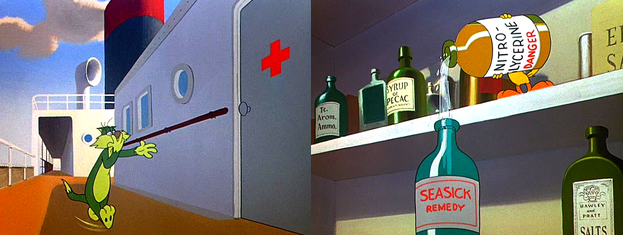
One of my earliest entertainment memories is of seeing on television the Warner Brothers cartoon, "Tweety's S.O.S.", and being mystified by a depiction of seasickness for which there was a bottled remedy located in a Red Cross room. And just what was that other liquid that Tweety Bird was mixing into the corrective that seasick Sylvester the Cat was about to drink?
More memories, albeit scattered, of these inaugural years of my life include seeing my mother and father laughing at an episode of the World War Two prisoners-of-war situation-comedy television series, Hogan's Heroes; closely, shyly, timidly accompanying my father while he drove a school bus as one of his assigned duties at Canadian Forces Base Rivers; laying in my little bed and thinking, wondering, about the seasickness remedy (and a spiked variant thereof) imbibed by Sylvester the Cat in a room with a Red Cross on its door and many (for me) enigmatically labelled other substances located therein, in the Warner Brothers cartoon, "Tweety's S.O.S.", wherein Sylvester is chasing Tweety Bird on a passenger ocean liner; watching Sesame Street episode segments with a Muppet detective character name of Sherlock Hemlock; and playing with my toys and walking within the narrow yard alongside the McCorry mobile home in its various locations. I rather vividly remember a sunny Saturday afternoon on which I was in our mobile home's narrow side yard and pacing about in anxious wait for the appointed start time of The Bugs Bunny/Road Runner Hour some while later that afternoon.
A substance poured by Tweety Bird into the aforementioned seasickness remedy in "Tweety's S.O.S." had a detrimental, altering effect on Sylvester after he drank the resultant amalgam. There was a label on that substance's bottle with the word, danger, in red lettering. And that had me both troubled and fascinated.

I was all-attention and appreciative and thoughtful at sight of such on-television presentments as gophers in a food processing factory (first image here), Yogi Bear's search for sustenance at imposed-by-man campgrounds (images two and three), and early scenes in the television special, A Charlie Brown Christmas (images four and five).
Also inducing me to contemplation and imprinting upon my mind through television viewing in this life era were the imposing and forbidding food processing factory into which two gophers came in search of their confiscated crops in a further cartoon on The Bugs Bunny/Road Runner Hour (in same instalment thereof as "Tweety's S.O.S.", actually), Yogi Bear's quest for sustenance in a stylised cartoon campground encroached-upon by man in cartoons of the Yogi Bear television series mostly shown in French as Yogi l'Ours, and the first scenes of A Charlie Brown Christmas (the annual classic television special which I believe I saw for the first time with CBC Television's 1970 broadcast of it), specifically the scenes of children skating on a pond and a melancholic Charlie Brown and his friend, Linus, walking in a snowfall set amongst foreground and background visuals of gorgeous and compelling colour palette. The ability of television to grab my attention and stir me to cogitation was very much in force in my life's first years.
By way of depictions such as these and several others, I was first introduced to some of the less than positive facets of human existence, quite often by subtle implication. My young mind did not entirely comprehend the meanings, but I was compelled nonetheless. I was always compelled, whatever be the connotation in what I was watching. And as I will delineate, some images on television would frighten, even terrify me, and at the same time impress me quite significantly. At times in my childhood, I would posit supremely optimistic outlooks on the universe, but there would also by times be a contrasting awareness, disturbing to me, of fallibility, mutability, or vulnerability. I suppose that all people do in their young age grapple mentally with such dichotomy in the world. But in my case, for a number of years, nearly all such rumination was done without the presence of any fellow youngsters. Impressions were most powerful, and sometimes I would have nightmares.

My maternal grandparents resided in Fredericton, New Brunswick, Canada. Fredericton, the New Brunswick provincial capital a hundred miles south of Newcastle, where my parents and I lived in the early 1970s. On one of my earliest remembered visits with my grandparents, my mother and my grandmother brought me to downtown Fredericton's Capitol Theatre (pictured here) for a matinee showing of some movie that I cannot recall. I just remember the experience of being at that movie theatre. It was demolished sometime in the early 1970s.
In later life eras, I would have friends with whom I could share reactions to entertainments, but I could still be alone in the degree, in the extent of my response to what I had seen, especially if it was connected somehow with impressions received in earlier years. My friends could develop a similar fancy for a work of entertainment to which I had become attached, and they could be encouraging of my interest in it, follow it- maybe even watch it- with me, and be willing to hear my identifiable reactions to it. But the amount and nature in some cases of my aesthetic and philosophical responses might not be kindred or understood. Even if I could satisfactorily put them into words, which was frequently beyond my capacity for communicating. At least one quarrel started because a friend did not understand my peculiar fixation on a particular concept. I failed to satisfactorily explain it, and he was not in empathy with me about it and became annoyed. And my "reading" then of his annoyance and its cause was far from precise, also. So, we simply fought.
And I would have a consuming yearning to possess the entertainments that had affected me, my efforts to acquire them dominating my thoughts by times. And I had a tendency toward introversion that began at a very early age (naturally, I suppose, considering my only-child, friendless state), such a tendency melding with my solitary deliberations about affecting entertainments and with my seeking to acquire them.
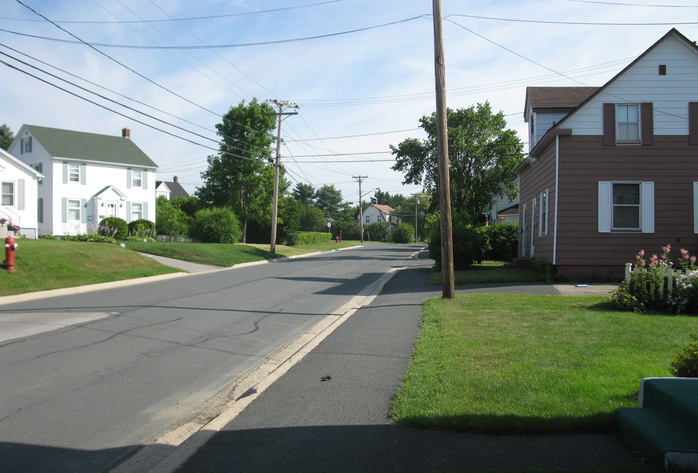
A view of Old King George Highway, Newcastle, as it proceeds toward the part of Newcastle where was located a trailer park in which I lived from 1970 to 1972. I remember walking with my mother on Old King George Highway to and from a gasoline station's store while I was ruminating about a number of television viewing experiences in this, my earliest life era. Photograph snapshot in July, 2011.
To a boy who spent his earliest years friendless and who could on occasions be completely wrapped in his own concerns, the forming of lasting, close relationships was to forever present quite a daunting challenge. It always amazed me how easily other people found and built friendships, and how the long-term retaining of their friends posed not the slightest complication. The process of meeting someone, leaving- if possible- a lasting, positive, first impression, and proceeding to join that person in whatever we agreed to do together, with mutual trust and respect arising naturally in the sharing of experiences, usually required a longer period of time for me than it did for nearly everybody else- and an inordinate amount of initiative and patience on the part of the other person. Most people found it easier to befriend others who were not as diffident as I, and they did so, without showing the slightest interest in quiet, seemingly standoffish Kevin. Some who were inclined to look in my direction with an eye to becoming pals, were quite possibly discouraged by my tendency to introvert and by my timidity at reaching out to them.
As I grew older and a bit more confident in socialising, in small groups or one-on-one situations at least, I became better at the practice of friend-making. But I would still lapse at times into the resigned, timid person that I had used to be, holding back and being slow or tentative to respond, which could and probably would leave friends wondering as to the quality of our relationship and the extent of my fondness for them. To be buddies with me requires patience, flexibility, understanding, acceptance, and, above all, an outgoing, easy-going personality. With people who lack these qualities, I have found friendship, if it does develop, to be quite turbulent, fraught with frequent misunderstandings and rather lengthy periods of chilly estrangement. And even with those persons, not very many, who do meet these criteria, I could still be quite a frustrating and disaffecting cohort. My perception of the cause-and-effect relationship of my actions, or lack of them, and the occasionally less enthusiastic than usual response of a friend to seeing me, was seldom crystal-clear. I would jump to the conclusion that my friend was moody, bi-polar, or just did not like me on a particular day. And I would respond by being offended, backing away. A friend would then have to determine entirely on his own, why I was acting like I was, be forgiving, and approach me again in a thoroughly outgoing manner. Again, not very many people have it within them to be so very generous with their patience and perseverance- and to regard their friendship with me as being important enough to go the distance, as it were, for me. Some do, for awhile, but their capacity for patience and forgiveness eventually becomes exhausted. In retrospect, I cannot blame them for leaving me behind. I do in fact salute them for tolerating my less sociable conduct and accepting me for who I was, for as long as they did.

The entry to Newcastle from the highway from Fredericton, New Brunswick, Canada. The welcome sign no longer exists. Newcastle and nearby communities were amalgamated in 1996 to form Miramichi City. Snapshot in September, 1996.
My parents and I moved to New Brunswick in the spring of 1970, when my father was transferred to the Canadian Forces Base in the northern New Brunswick town of Chatham. Chatham and Newcastle were twin towns in New Brunswick's Miramichi region, on opposite sides of the spacious Miramichi River, with neighbouring villages Nordin, Douglastown, Millbank, Loggieville, and Nelson-Miramichi, all also situated along the beautiful river. Our mobile home, the same one that we had in Rivers, was positioned for a short time inside of a trailer park adjacent to the Bathurst highway along the northwest fringe of Douglastown, which was directly across the Miramichi River from Chatham and a few miles down-river from Newcastle

A meeting of two Georges: King George Highway and George Street intersection in Newcastle in a September, 1996 photograph.
My mother worked at the V.O.N. office in the Miramichi Regional Hospital, and while we were residents of the trailer park next to the Bathurst highway, I stayed daily with the Nickolitian family, who had a house just beyond the limits of the near-Bathurst highway trailer park. The Nickolitian children were several years senior to me. All that I remember about my many hours as a guest of the Nickolitians is that one of the daughters had green eyes, Romper Room was watched on television at 10 o'clock, and the Nickolitian canine one day bit me- and I bled, resulting in a fear of dogs. Now, this is a surprising revelation, for all who have read my Littlest Hobo Page!

The mobile home in which my mother, father, and I lived prior to 1972, situated in a trailer park in Newcastle, New Brunswick, Canada. A May, 1989 photograph.
In summer of 1970, we moved to a trailer park in Newcastle. Our mobile home was located at the back of the trailer park, and railway tracks were a short distance behind our place, through a clump of trees on a slight incline. I used to run up to the tracks to watch the trains pass. To the right of our trailer was a wooded field, where acquaintances sometimes flew kites.
The Newcastle trailer park was in the northernmost sector of Newcastle, adjacent to Old King George Highway as it was nearing a nature enclave called French Fort Cove. My parents and I would stroll Old King George Highway, sometimes walking south as far as a gasoline station and small convenience store that was situated at a fork in King George Highway, which was known as the "main drag" of Newcastle. Old King George Highway was the left side of the road fork. And the right side of the highway, the main King George Highway, went to the northern perimeter of Newcastle and then through Nordin, thereafter becoming the main street of Douglastown, eventually intersecting with the approach to the Chatham Bridge and the aforementioned Bathurst highway. And after that, it became the Neguac highway, passing through Millbank.

Newcastle domicile of the Waye family, as photographed in May, 1989.
Due to my mother's weekday work schedule, I was the responsibility, Monday through Friday, of Mrs. Waye, a lady who lived just outside of the Newcastle trailer park. Her two sons, Jimmy and Dwayne, collected comic books, and I loved to read them. Jimmy was the same age as myself, but our temperaments were drastically different. He was verbally and physically aggressive- and rather intimidating. I learned quickly that it was in my best interest to cooperate unconditionally with him to the extent that, in our relationship (one of necessity rather than one of choice on either of our parts, I believe), he was dominant while I was passive. This was no doubt a significant factor in the development of shy aspects of my personality. Certainly, lack of siblings and a dearth of friends and interaction with peers in my earliest years also contributed to my shyness, which I would gradually, though by no means entirely, overcome in more agreeable surroundings.

Downtown Newcastle in spring, 1970.
The more agreeable surroundings to which I refer, would be in the village of Douglastown, where I was to live from 1972 to 1977 (Era 2). Miramichiers have a reputation for modesty and friendliness, which I believe is indeed very true. But within the Miramichi area, there are, I believe, differences, variations in the congeniality of the populace. Douglastown seemed to me to be a friendlier place than Newcastle, with Chatham friendlier than Newcastle but less so than Douglastown. I think that this has something to do with Newcastle being more city-like in its distribution of homes and businesses and in its function as an administrative hub for the Miramichi region. The New Brunswick capital city of Fredericton, consisting largely of bureaucrats and university professors and a service sector catering to officious types, tends to be a Jones-competing-against-Smith community of upward-mobiles seeking "coolness" or permitted entry into coveted, exclusive cliques. As such, Fredericton is a much less accommodating and accessible place than is the Miramichi, as I was to discover in years to come (in Era 3). Within the Miramichi, Newcastle is slightly more bureaucratic than is Chatham, which was, in the 1970s, a military and industrial community. And Douglastown, being semi-rural in those years and offering a more relaxed pace of life, was the true centre of Miramichi hospitality.
My memories of Newcastle are mostly of being rebuffed and of lingering- or languishing- on the outside of the action among the pre-school inhabitants of my trailer park or of timidly accompanying Jimmy on some of his outings to join his friends, who lived in houses along the perimeter of the trailer park. All of them clearly had no interest in my joining them and tolerated my presence only because I was with Jimmy as per his mother's wishes. On one day, Jimmy and his colleagues were building a tree house. I was reticent to join them, and sensed that I was unwelcome to do so in any case. I kept somewhat distant from Jimmy and company whilst they collaborated on the construction of their arboreal place of assembly, and soon returned by myself to Jimmy's mother at the Waye house, outside of which was a vast field where I helped Mrs. Waye to extract yellow beans from her garden. I also recall going with her to a neighbour's house and standing next to her in her kitchen as she cooked lunch and going with her into a downstairs apartment (the Wayes lived upstairs in a split entry, two-story apartment dwelling) to do her laundry.

Saturday television fare for me in the early 1970s included Batman, Rocky and His Pals, Le roi Leo, The Bugs Bunny/Road Runner Hour, and The Galloping Gourmet.
In the years in which this was the state of affairs, I recall seeing a Moon landing; trick-or-treating in a Bugs Bunny costume (chaperoned, of course, by my mother); fretting on many a Saturday afternoon when baseball or football games or other live sports events typically exceeded their allotted broadcast time (2 1/2 hours, for the baseball and football games) and caused The Bugs Bunny/Road Runner Hour to be joined already in progress, sometimes by as much as 45 minutes; playing cars in the sand with Jimmy; and watching such weekday daytime television shows as Sesame Street and The Friendly Giant at the Wayes' place and Batman, Rocky and His Pals, Le roi Leo, and, of course, The Bugs Bunny/Road Runner Hour, on Saturdays at home. I remember The Galloping Gourmet airing after The Bugs Bunny/Road Runner Hour on several Saturdays in 1971. For a time, i.e. autumn of 1971, winter of 1971-2, spring of 1972, there was also a Bugs Bunny and Friends television series shown on weekdays within the dinner hour. I can envision my mother collecting me at the Wayes' place on a number of days as an instalment of Bugs Bunny and Friends was starting.

Disturbing and downright frightening phenomena of cartoons seen by me in pre-school years: Wile E. Coyote with a bottle of earthquake pills, the contents of which he ingests almost entirely, and tiny Tweety Bird turning many times into a horrendous mutant of evil intent after being exposed to a chemical in a laboratory.
Seeing a multi-eyed Muppet monster or watching Wile E. Coyote swallow a bottleful of earthquake pills was unsettling, but a cartoon ("Hyde and Go Tweet") in which tiny Tweety Bird changed repeatedly into a large, evil-eyed beast due to exposure to a liquid gave to me disturbing dreams. My grandparents brought a plush toy to me when I was ill for a short time in a Fredericton hospital, and the toy was a large husk of a bird with eyes that reminded me of the transformed Tweety!
On a number of occasions I observed as the local youngsters, oblivious to my presence, flew kites or played children's games around a wooden shack on the Newcastle trailer park grounds. Further, I recall there being a hay ride on a sunny summer afternoon, the horses and carriage moving through the trailer park and passing by my mobile home abode. I wanted ever so much to climb aboard the hay ride carriage and enjoy the event with the boys and girls, but I was resoundingly denied permission to embark upon the hay ride vehicle, and I ran to my home, deeply upset at the rebuff.

Bugs Bunny and Friends, a weekday offering on television presenting Warner Brothers cartoons in half-hour episodic compilations, was a television attraction in 1971 and 1972 for a retiring tot name of Kevin McCorry on late afternoons, Monday to Friday.
My cautious and diffident attempts to find acceptance among the neighbourhood youngsters being consistently spurned, I retreated ever further to my television viewing experience, most especially The Bugs Bunny/Road Runner Hour on Saturday afternoons- and that suppertime, weekday run of Bugs Bunny and Friends. I remember the Saturday sports coverage continuing to wreak havoc upon The Bugs Bunny/Road Runner Hour, and a cartoon, "Dr. Jerkyl's Hide" (the one with Sylvester drinking that disturbing transformation formula and frightfully removing the swagger from a brutal bully bulldog), joined already in progress following some live sports telecast, my first glimpse of the Merrie-Melodie-Looney-Tuney cartoon action on that day being a scene of a monstrously transformed fly advancing menacingly to a laboratory door and slamming said door shut.

Dig, Adventures in Rainbow Country, and The Beachcombers. Sunday evening programming on television in the early 1970s. The Beachcombers premiered in 1972.
I also remember a Sunday evening animated cartoon television special called Dig, which was about a boy and dog falling into a large hole to somewhere, and, regularly on Sunday evenings, Adventures in Rainbow Country, a produced-in-Canada outdoor excursion television series starring Lois Maxwell (Moneypenny in the James Bond movies) as the widowed matriarch of a family owning and operating a lodge in the wilderness of northern Ontario. The Beachcombers, the iconic, 18-year-long-running Canadian television opus about Pacific-coastal, stray-log-seeking boaters, replaced Adventures in Rainbow Country in the Sunday evening viewing slot in 1972. I vividly remember the evening when The Beachcombers premiered.
The printed word was very compelling to me in my early years. And I was, in this, my first life era, becoming very much impressed by the titling of television programmes, cartoon title cards like those of The Bugs Bunny/Road Runner Hour, and signage and labels seen in television shows. Indeed, the titling to Dig was an image that would stay imprinted upon my grey matter for many decades. My memory of it would be more vivid and lasting than that of any other visualisation in the television special. I remember the first Bugs Bunny/Road Runner Hour cartoon title card to leave an impression upon me as being the one for "Birds of a Father", a cartoon notable also for another reason, as I will delineate. It was the first cartoon title card that I remember reading from start to finish, the words, birds and father, having already been familiar to me in their spelling.
A frequently recurring set of television images and sounds back then was that of a Public Service Announcement from the Department of Health and Welfare (of the federal Canadian government, I would hazard to guess), which was identified in on-screen text at the end of the Public Service Announcement. A distinguished-looking man in a fancy suit and a woman of grace and a discernible sophistication were shown dancing elegantly to a waltz on a stage. Both of them had a cigarette in their mouth and became increasingly distressed as their coughing due to cigarette emission intensified. The gentility in their countenances eventually gave way to a look of baseness and sickness. They continued dancing. Until their coughs became so severe that dance was replaced by stagger and their coughs reached a crescendo of desperate gagging, before a freeze-frame and the notation of the government department from where the Public Service Announcement had originated, was printed on screen in capital letters. The images and sounds of the Public Service Announcement were disturbing to me, and anti-smoking Public Service Announcements, as this one was, would continue to have such an effect upon me in my next subsequent life era. They were severe and dire in their depictions and tended to intimate a duality in human nature. Sophistication and corruption. People clearly striving for the former and succumbing to the latter. A physically transformative duality, by times. Rather the same duality that was, that would be, manifest repeatedly, and sometimes more monstrously, in animated cartoons in my experience. My understanding of it was far from developed, though.
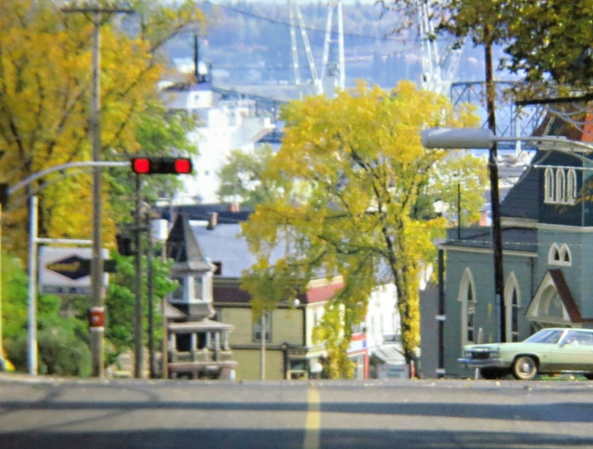
An early-to-mid-1970s photograph of the intersection of Prince William Street and King George Highway in Newcastle. Green edifice at right in photograph was the location for Sunday school for me in the final months of my first life era.
As my commencement of Grade 1 was approaching, my parents became rather anxious at my cloistered life potentially handicapping me from fitting into the social milieu of elementary school. To provide what they thought would be ample opportunity for me to mingle with other children, they, in the first months of 1972, enrolled me in Sunday school at a Newcastle church, on Prince William Street just below the intersection with the King George Highway, the main road in Newcastle. At that church, I have memories of going to a series of downstairs rooms with rows of desks, chalkboards, and colouring books. All but one of the other children there were ignorant of my presence. The one young fellow to give to me attention was both my namesake and a resident of Douglastown, a place to where I was soon to move.
My namesake with me in Sunday school was Kevin MacD.. I would have him as classmate through all of my first five years of schooling. But that for another life era. In my encounters with him at Sunday school in this inaugural era of my life, I was much too shy to talk about such things as favourite entertainment. Certainly not works of entertainment that were disturbing to me. I do not think we said much to one other in Newcastle Sunday school outside of learning one another's names and where we lived. I looked forward each Sunday to seeing him.
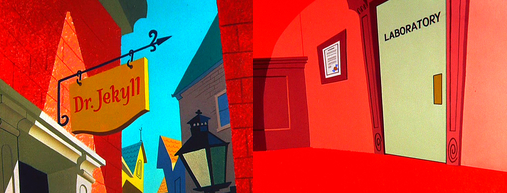
Location signifiers for a setting of fright and potential mayhem in a certain Bugs Bunny cartoon that I saw on television in early-to-mid-1972.
One weekday evening in early-to-mid-1972, before the six o'clock news, after my mother had collected me at the Wayes' house and brought me to our humble home, a New Brunswick television station (either CKCD- Campbellton/CKAM- Upsalquitch or CHSJ- Saint John, the former of which airing Bugs Bunny and Friends and the latter thereof televising a 20-minute block of cartoons designated as simply Bugs Bunny) showed a Bugs Bunny cartoon, which I learned more than 17 years later was entitled, "Hyde and Hare". The cartoon's title probably was shown that evening, but I retained no memory of it; I probably could not read it fast enough to process the words in my mind.

A "rabbit-feeder" pretending to be a doctor? My six-year-old mind did think so. And there in the hand of this "physician-playing" friend to Bugs Bunny, was a glass containing the beverage of my nightmares. Down the hatch it went, metamorphosis occurred, and fright was upon me.
The cartoon opened in a park, where Bugs met a meek and generous, carrot-providing, little man, who, to my six-year-old mind, seemed to be working as a "rabbit-feeder". Bugs and the man flirted, and I thought that he said to Bugs, "I'll be your doctor," before he carried Bugs out of the park and to a doctor's place, a Dr. Jill's (again, I could not spell very quickly at that age; so, I did not correctly read the name on the signboard above the doorway as that of Dr. Jekyll). I thought they were going to play doctor. In this context, which I discovered years later was not the correct one but only an interpretation from a six-year-old's perspective, Bugs and the "rabbit-feeder" assumed the respective pretend roles of patient and doctor. Bugs played the piano in a "waiting room" while the man went into a room marked "laboratory" that was dimly lit and filled with eerie test tubes and beakers. When the man saw a glass of fizzing, red liquid, he launched into a bizarre act of adoration and denial. I could not understand it, though the laboratory visualisations, reminiscent of those in "Hyde and Go Tweet", conveyed to me cause to become tense. When he started drinking the liquid, I knew for certain what was to happen. Not even Bugs Bunny was free from the horrors of that transformation formula!

Images of cartoon horror conveyed to Kevin McCorry, who was seated before his television one fateful evening in early-to-mid-1972.
I was petrified by the events that followed as Bugs- the usually imperturbable and in-control Bugs- frantically fled from a horrible, knuckle-dragging, green monster into which the man again and again transmuted. The man kept changing into a monster with clear potential for unlimited mayhem, and while the man was the monster, what had become of his awareness, his consciousness? I found that direction of enquiry to be especially creepy. Bugs' fright was palpably intense. And then at the end of the cartoon, Bugs himself turned green and monstrous!
After the cartoon concluded and a news broadcast started, I pulled myself up from the floor and walked dazed into the kitchen to join my mother. I struggled to eat supper as the events of the cartoon kept replaying in my mind. The events and their visualisations. The fancy signage above the doorway to the doctor's domicile. The word, laboratory, on the door to that awful place with that red fizzing potion. The horrible, chemically induced transformations of the "rabbit feeder" into the revoltingly green monster and the spine-chilling menace in its red eyes. Bugs in the "waiting room" playing the piano while the monster emerged from the laboratory. The axe being wielded by the monster as it pursued Bugs through the ornate candy-red, crimson, and wood-brown surroundings of the doctor's partly tenebrous living room. The scene in the dark closet as a transformation occurs. And Bugs himself turning green and monstrous with no resolution to that condition.
The colours in the cartoon were integral to it being as impactful for me as it was. The ugly green complexion of the monster, the shade of red of the fizzy concoction imbibed by the "rabbit-feeder", the reds in the doctor's living room in which Bugs is terrified by the murderous creature. All juxtaposed with the blue sky and sunlit, lovely green vegetation of the park. Seeing the cartoon in black and white would have weakened its effect upon me rather immensely, I would say.
I started having dreams that would persist into my ninth year, dreams in which a friend or acquaintance would drink the red potion and involuntarily change into a green-skinned maniac, and when he returned to normal, I would be frantic to distance myself from him before he changed again into the green monster.

My incipient admiration of the work of animated cartoonists found some of its emphasis in the visualisations of what had come out of Warner Brothers' cartoon-animation studios, for instance the Victorian structure in the background in a scene of the cartoon, "Birds of a Father", shown here in this picture.
My mother urged me to visit the Miramichi Regional Hospital where she worked, to look at the laboratory and to prove that Hyde formula was not real. But the sight of the beakers and test tubes upset me all the more. I even for a time mistook the word, library, for laboratory, and with sight of an old-fashioned library in Newcastle (the Old Manse Library), I thought that a doctor had a laboratory of horrors therein, and one in the hospital, too. The design of many of the houses and other buildings in Newcastle was curiously correspondent to the architectural style of background or foreground edifices in Warner Brothers cartoons, "Hyde and Hare" included, along with "Dr. Jerkyl's Hide", "Hyde and Go Tweet", and "Birds of a Father"- wherein naive Sylvester Jr. learns from a book prominently labelled "Cat Psychology" that, contrary to his amiable rapport with a winged, blue friend, cats must stalk and kill birds, while a culturally refined Victorian house is seen in the far background. I was constantly reminded of cartoon visuals (be they visuals of mirth, as they mostly were, or visuals, sometimes, of unsettling import) as I looked out the windows of our car at the Newcastle homes and business district stores that we were passing, my experience with the real world and the cartoon visuals blending in my mind, intertwined in memory. It follows that my recollections of cartoons on The Bugs Bunny/Road Runner Hour and the weekday Bugs Bunny cartoon compilation television shows can be very evocative of what it felt like to be a very young boy living in the Miramichi region- or visiting my grandparents in the old-fashioned West Plat area of Fredericton, the bulk of my childhood, indeed almost an entire lifetime, ahead of me.
For some reason, "Hyde and Hare", the Bugs Bunny cartoon that had so frightened me, was not one of the most frequently shown, because I was not to see it again for the next seventeen years, although I was a loyal viewer of the cartoons of Bugs and company for most of that time, watching the rabbit and his cartoon cohorts on whatever compilations of their cartoons were available to me on television. The Bugs Bunny/Road Runner Hour. Syndicated packages of the cartoons. Showings of them in French. Et cetera.
On the day that my mother brought me to the Miramichi Regional Hospital to observe the laboratory there, I was playing cars in the sand at the foot of the driveway to our mobile home. She had just arrived home in her car and had evidently conceived the idea of showing the laboratory to me, at some moment in time during her work day. Stepping out of the car, she approached me with the idea and was quite determined that I proceed with it. I did not require very much prompting, actually, as I had a curiosity, albeit steeped in trepidation, about the look of a laboratory outside of the world of animated cartoons. It was a sunny, bright afternoon. Presumably late in the spring or early in the summer of 1972.

As seen in a late-1960s or early-1970s photograph, the Miramichi Regional Hospital in Newcastle, where my mother worked and at which there was a laboratory that my mother showed to me one sunny day in 1972. Like many structures regarded by me in my formative years, it had a distinctly Victorian outside appearance.
Located along the King George Highway in Newcastle, the Miramichi Regional Hospital was a construction of the second decade of the twentieth century, when Victorian architectural styles were prevalent in building design. So, again was there an edifice of my early youth in the Miramichi region whose Victorian appearance meshed in my mind with the Victoriana of structures in cartoons. And one cartoon most particularly. "Hyde and Hare". The hospital laboratory on one of the upper floors had in it all of the measuring bottles and chemical mixture containers that had been distinguishing characteristics of the disturbing chemical workshop in "Hyde and Hare". And also that in "Hyde and Go Tweet". The cheerful, personable disposition of the young woman working in the laboratory, to whom my mother introduced me and explained my peculiar nightmare-fuelling fascination, did not help to shake me free from disturbing impressions. Quite the opposite to that was the outcome of that afternoon trek to the laboratory. I mean, Bugs' "rabbit-feeder" friend was agreeable, very much so, when he was not transformed into that green-complexioned monster. But to my mother's credit, she did try to impress upon me that laboratories are benign places devoid of horrible appearance-changing and personality-changing substances. She tried. Yes, she tried. To my mind, though, perhaps she may have been unaware of some terrible, shadowy secret of the scientific profession. Just that the idea of such a thing existed was disquieting enough, with the laboratory that I saw in the hospital that day giving to it rather a tangible reality. My nightmares would grow more frequent and more vivid.

With a childhood enthusiasm for vinyl records and music thereon, my tastes in tuneful sound included the jazzy compositions of Herb Alpert and the decidedly more raucous songs of the Osmond Brothers.
Danger signs (the skull and crossbones) were another unsettling fascination. A more agreeable impression was formed by the melodies of Herb Alpert and the Tijuana Brass. My father had a vinyl record of some of their music, and some of the vinyl record's selections ("Lonely Bull", "Mexican Shuffle", "Tijuana Taxi", "South of the Border") emphasised Mexican culture and utilised Mexican styles of energetic musical "beat" or rhythm. The selections were a Southern U.S. jazz with heaps of Mexican flavor in tuneful composition. I loved them. And I think such love led eventually into a fancy that I had for Mexican culture portrayed in a certain episode of The Flintstones seen by me in the latter half of my second life era. A particular strong memory associated with that Herb Alpert and the Tijuana Brass vinyl record was of me listing to the final selection ("Zorba the Greek") on the vinyl record's second side before going to Sunday school one overcast Sunday in spring of 1972.
I later had vinyl records of my own with music from the Osmonds ("Crazy Horses"), the Beatles, Ray Stevens ("Ahab the Arab"), and Sammy Davis Jr. ("The Candyman"), in addition to such "kiddie fare" as The Aristocats, The Jungle Book, 1001 Dalmatians, and "Rudolph the Red-Nosed Reindeer". And given to me by my parents for Christmas in 1971 (the same Christmas on which my father received his vinyl record of Herb Alpert and the Tijuana Brass music) was a vinyl record with children's songs, and I remember being especially appreciative of "The Little Engine That Could", one of the more renowned songs on that Christmas-present-for-Kevin vinyl record.
There was also a stirring passage of music on a Sesame Street segment in which a flower, dripping with dew or early-morning rain water, slowly opened to greet a new day and the camera zoomed outward and panned leftward to show the plant atop a building in a large city.
One morning, my mother and I were descending the stairs in a building in downtown Newcastle. She was carrying me and lost her footing. We fell to the bottom of the stairs, and it was a miracle that neither of us was seriously hurt! We went to hospital to have ourselves examined, and our injuries were pronounced minor. We arrived back at our mobile home, and I switched our television to on-mode and saw the Sesame Street flower segment described in the paragraph immediately preceding this one. I found the music used for that segment, i.e. Vivaldi Guitar Concerto in D Major, Second Movement, to be quite soothing to my jangled nerves.

Four images from a view from a moving motor vehicle going through Newcastle, New Brunswick, Canada in July, 1971. Which was during the years in which I lived in Newcastle. Top left image is of the King George Highway as it approached the Newcastle Dairy Queen fast food restaurant, a restaurant at which I ate many a meal in my years as an inhabitant of the Miramichi region of New Brunswick. The Dairy Queen is the first structure from foreground in the left half of the image. Past the Dairy Queen were a Fina gasoline station, the Kingsway Restaurant, and the Miramichi Mall. Top right image shows King George Highway after it having passed the Miramichi Mall, and as it was approaching a railway crossing and then the residential zone of Newcastle starting with Millar Avenue and Willow Street. Bottom left image is of the King George Highway on its approach to the Sinclair Rink (the prominent structure in left half of image) and a Texaco gasoline station, one of two Texaco gasoline stations along the King George Highway in Newcastle. Bottom right image shows King George Highway after it having departed Newcastle at Newcastle's northernmost frontier and as it was crossing French Fort Cove on its way to the villages of Nordin and Douglastown. Our car, my father and I inside of it, ran out of gasoline on King George Highway approaching Newcastle town limits and the Cove Road beyond, one day after a shopping expedition. Our car would, at that time on that day, have been stationary in the lower left quadrant of the image.
Another memory which imprinted upon my earliest impressionable brain a lifelong fear of my car running out of gasoline, was an incident in which that precise thing happened while I was accompanying my father on a shopping expedition to a meat market in Nordin near Douglastown, and we were returning to our trailer park home, approaching the Cove Road that led to the entrance to the trailer park. We were on the King George Highway where there was a dip in the road, with a magnificent, forested cove on one side and the bulging Miramichi River on the other. The Cove Road was ahead to the right when our car came to dead stop. I asked my father what was wrong, and he pointed to the fuel gauge which was completely shifted in the direction of the letter, E. Evidently, he had thought there to be enough gasoline in the car's tank to reach our home and subsequently go to the nearest service station for a refill, but he had overestimated the remaining fuel supply. The feeling of being stranded on the road, even though home was only a short distance away, was palpable, and I was more than a little upset. Fortunately, in no time at all, a Good Samaritan came along and transported my father and I to the closest service station for a container of sufficient gasoline to complete the remaining distance to home and then to service station for a full replenishing of the motor-powering liquid. Ever since that day, I have never allowed a fuel tank to run anywhere close to the letter, E, and have been quite the pest as the passenger in a car whose driver has allowed the fuel gauge to come perilously close to the letter, E.

A mid-1970s photograph of the intersection of Prince William Street, Water Street, Castle Street, and Pleasant Street in downtown Newcastle. In foreground at lower right corner of photograph is the top of a street light on hilly Prince William Street as it is about to intersect with Pleasant Street, which proceeds beyond the right edge of this photograph, Water Street, which goes to left in photograph, and Castle Street, which extends into distance in photograph past the beige, orange, and brown structure. Situated aside the sidewalk of Water Street is, as seen in left section of this photograph, the meat market and grocery store that was one of two places to where my father went for meat.
In addition to the meat market in Nordin, there was a place in downtown Newcastle to where my father went to buy meat. It was a meat market and grocery store. The lady running the grocery store part of that downtown Newcastle business sold penny candy, which always sweetened the experience of going to there, as my father and I awaited my father's requested cut of meat from the butcher. My father and I continued to go there in the first couple of years after we moved out of the trailer park in Newcastle.
Also in downtown Newcastle was a photography studio on the floor above a photography and hobby store located in the Newcastle town square, and my mother brought me there one day to have a portrait-sized photograph done of me. The photographer was a kind man and very obliging of my mother's desires for the portrait-sized photograph. That was in mid-summer of 1972, I seem to recall.
Printed signage outside of establishments was fascinating to me as I was into my sixth year of life. Sparked mostly by how Dr. Jekyll's name had been displayed in that scary Bugs Bunny cartoon, this particular keen interest had me regarding with wide-eyed wonderment the signs, especially protruding and hanging ones, outside the entrances of businesses in downtown Newcastle. And when the signs and the buildings to which they were attached had a Victorian look to them, all the more intent was my fascination. My mother assented to my placements of printed signs on the archway of my bedroom in our mobile home. And the word, laboratory, marked on a narrow, rectangular sign protruding outside of an entry way was, for me, both unnerving and compelling.
In a number of the months of the first half of 1972, I, as previously stated, went to Sunday school in Newcastle, and there met another Kevin who lived in Douglastown. I did not then know that he and I would later be classmates at Douglastown Elementary School and would in those years become friends.
Having lived in the Miramichi region for some two years, having become established in their places of employment, and seeing their financial situation becoming somewhat assured, my parents were looking in mid-1972 for a larger home in which to raise me through my school years. And they found one. Not in the residential zones of the town of Newcastle. Not in those of the town of Chatham. But in a locale that was semi-rural, with many spacious yards and perspectives of the Miramichi River, fields, trails, churches, and variable constructions of houses.
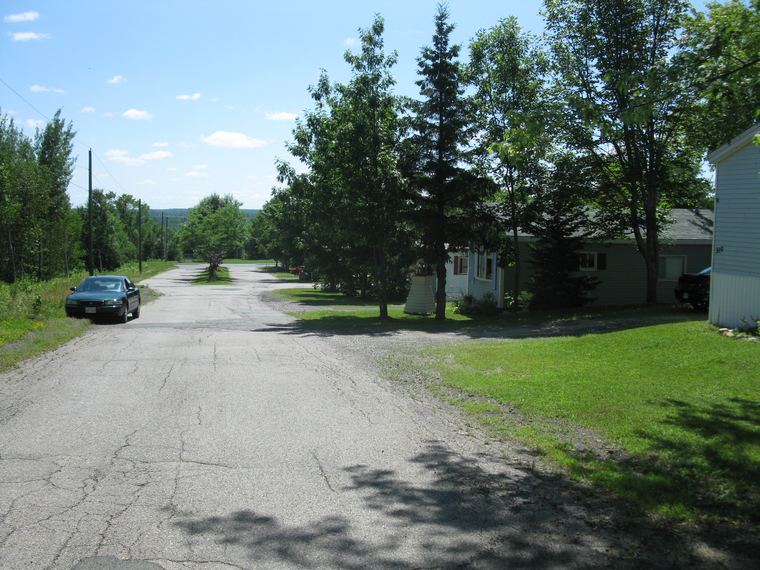
A July, 2011 photograph of a street of the Newcastle, New Brunswick, Canada trailer court in which my parents and I lived from 1970 to 1972. This is a perspective of that street from in front of our 1970-2 driveway in the trailer court, with the street receding into the distance, forking near an intersection with Newcastle's Old King George Highway. Effects of the passing of nearly four decades of time aside, this was the sight that I beheld on the sunny day in July, 1972 on which I stepped into the back of a truck carrying some of our belongings as we were moving to a new home, a new home in the village of Douglastown.
And so it was that in July, 1972, on a sunny, warm (not hot) day, my parents and I moved out of our mobile home in Newcastle and into a house in the village of Douglastown. I have memories of that moving day, of climbing into and riding in the back of a truck containing some of our belongings, disembarking the truck in our new home's driveway, and walking in awe inside the not as yet fully furnished house.
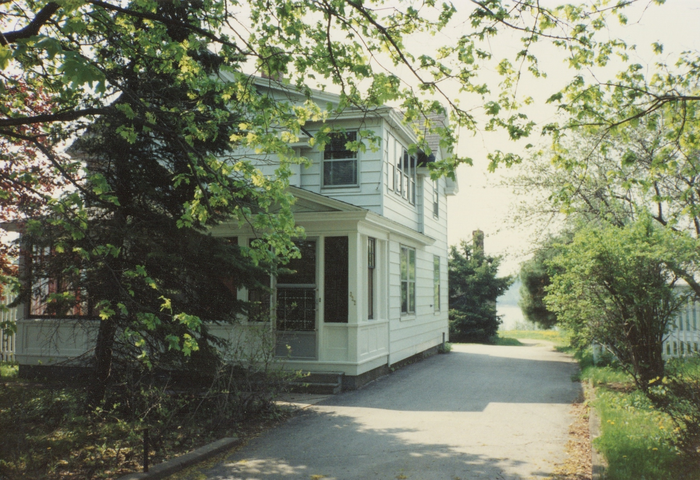
McCorry residence in Douglastown, New Brunswick, Canada from 1972 to 1977, with old church hall behind it, followed by the magnificent Miramichi River. My bedroom was on the upper floor and, most of the time, had the last window toward the background on the right side of house as seen in this photograph.
To a boy who was accustomed to the small-scale rooms of a mobile home, the house was like a castle! Ceilings were higher. I had two rooms to choose from for my upstairs bedroom. Entered into by the house's back door, there was a spacious kitchen separate from the dining room, which led into a seemingly vast living room, on one side of which was a stairwell that had a 90-degree turn two-thirds of the way up, as it led to the upstairs. And there was a basement, a veranda, a patio, a two-storey garage adjacent to but separate from the house, a quite spacious, fenced side yard, and a backyard bordered by a string of evergreens. The front yard was magnificently shaded by three fully-grown trees. The house was ideally situated on the main road in the village before the road dipped over a mini-tributary to the Miramichi River. The river itself was a short distance behind our house. A gravel back road separated our yard from that of an old church hall on the riverside and from the home (also along the river) of a younger fellow named Michael, who was to be my closest friend. Across the dip in the main road, on the same side of the road as our house, was Douglastown Elementary School, which in the 1800s had been a shipbuilder's home. It looked like a large house, with a portable classroom behind it, on the riverside. Douglastown Elementary School only went to the end of Grade 5, with one class for each grade. In early 1973, with the addition of a second portable classroom, one room in the main building was converted to a library.
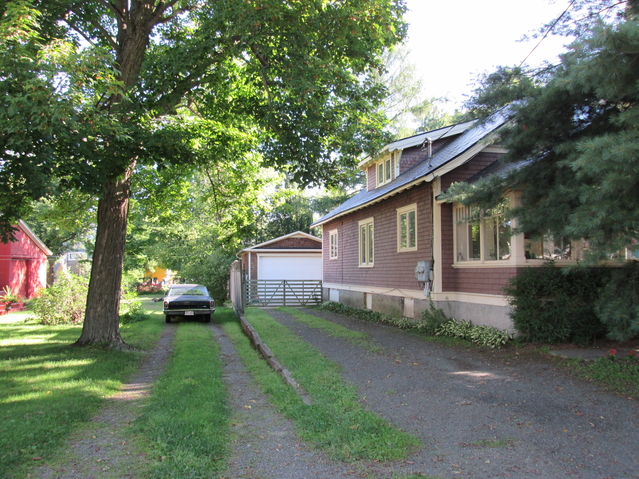
My grandparents' Saunders Street house in Fredericton until 1973. Brown in colour. And it had, from its rear windows, a view of homes of a street behind it. The window farthest back in this photograph was of the room where I slept when visiting my grandmother and grandfather early in my life. Photographed in August, 2015.
My mother, father, and I moved to this wonderful home in Douglastown two months before I began Grade 1 at Douglastown Elementary. Said my grandfather in a July, 1972 entry in his diary, "The McCorrys have an impressive house." A vague memory that I have, which was revisited with a reading of my grandfather's diary many years later, was of staying with my grandparents in Fredericton in the summer of 1972. They had quite the abode themselves, an old-fashioned, brown, two-storey house on Fredericton's Saunders Street between Smythe and Northumberland Streets. I have recollection of sitting in the front veranda while my uncle Fenton read to me a children's text-and-picture book, Teena and the Magic Pot, about a custard pot overflowing and flooding a house. I also remember sleeping alone in a back room on the ground floor of my grandparents' house and looking out a window and seeing the distant and elongated backs of the row of houses on the next street. There was a cartoon on The Bugs Bunny/Road Runner Hour called "Canary Row" that opened with a camera pan across some San Franciscan Victorian architecture, of which the old-fashioned houses in my grandparents' neighbourhood in Fredericton reminded me frequently. As did the word, row, which I tended to associate with city blocks of houses like those in the vicinity of my grandparents' house.
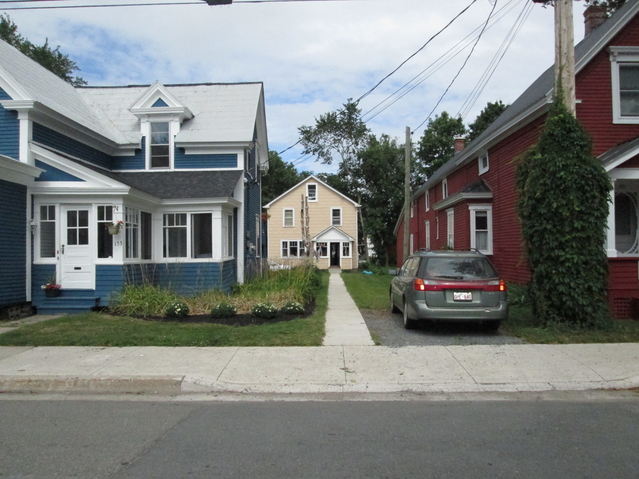
While riding my tricycle on the sidewalk, I, in the early 1970s, saw houses such as these near to my grandparents' Saunders Street residence in Fredericton. An August, 2013 snapshot.
On a particular visit to my grandparents in Fredericton (during which I mirthfully rode my tricycle on the sidewalk of Saunders Street), for some reason I remained there for a few days after my parents returned to our new home in Douglastown, and the plan was for my grandfather to bring me in his car halfway from Fredericton to Douglastown, rendez-vousing with my father in the town of Doaktown, some 60 of the 100 miles between Fredericton and the Newcastle-Douglastown-Chatham Miramichi region, with me switching cars from my grandfather's to my father's, and for my father to bring me the rest of the distance to Douglastown, and my grandfather to return to Fredericton. But they missed each other at the meeting point, and my grandfather completed the journey to Douglastown, going past our house there and eventually stopping at a general store a quarter-mile or so past the Chatham Bridge, on the road leading to Millbank, Bartibog, and Neguac. I think that my grandfather used the store's telephone to contact my grandmother in Fredericton to enquire whether she had heard from my father, and I guess that he was informed of my father turning his car around at Doaktown and driving it back to Douglastown. A short while later, the rendez-vous happened outside my Douglastown home, I was transferred from grandfather to father, and my grandfather returned to Fredericton. It was a memorable experience, even if I may be somewhat cloudy on some of the details!

Images of four views from a moving car in Newcastle, Nordin, and Douglastown, Miramichi region of New Brunswick, close to the time in 1972 when my parents and I moved from a trailer court in Newcastle to a house in Douglastown. Top left image shows the forking in the King George Highway in northern Newcastle, at a Shell gasoline station and small convenience store. Going to the left at the fork in the road brings one to the trailer court about a half of a mile up that road, Old King George Highway. Turning to the right at the road fork puts one on the King George Highway route to Nordin and Douglastown. Whenever my parents and I were returning to home in Douglastown after doing something in Newcastle, we would turn right at the road fork. Top right image shows an Esso automobile service station in Nordin that had my fancy for a time in the earliest days of our living in Douglastown. The entrance to the Douglastown village limit was not far down the road from there. Bottom left image shows the main road of Douglastown a short distance within the village limits. Prominently seen on right side of the road is the house wherein one of my friends would reside from late 1973 onward. In the far distance is Douglastown Elementary School. Bottom right image is a view of our Douglastown house being approached from Douglastown's main road. That house is to the left of the foreground pole.
In my earliest days as a Douglastown resident, I passed some time with play with toy cars outside the front door of our new house, and I fancied the look of the Esso automobile service station in Nordin on the King George Highway and tried to replicate the appearance of that in miniature in my toy car play. I remember one sunny morning in 1972's summer playing service station attendant outside our house's front door, with my toy cars and miniature automobile service station, and for a short time I aspired to becoming an attendant at an autombile service station.

As my parents and I were settling into our new home in Douglastown, I indulged in some play with toy cars of the sort shown in this image, and a representation in miniature of an Esso automobile service station in Nordin, in which I pretended that several of my toy cars were being fuelled or repaired.
Toy cars constituted one of my first acquisitive pursuits. And in this respect at least, I suppose that I was a fairly ordinary young boy. Said acquisitive pursuit of toy cars would predate my yearnings for possession of books and of recordings-on-media of my favourite television programmes. The motivation to own that which I fancied had its beginnings quite early in my life. And my aesthetic tastes for imaginative opuses would flower alongside my desire to acquire.
I also have memories of regarding in those, my early Douglastown days, our impressive new home from various perspectives, including one from the other side of the road at the southern end of the wooden bridge that ran over the Miramichi River mini-tributary separating my home area from Douglastown Elementary School.
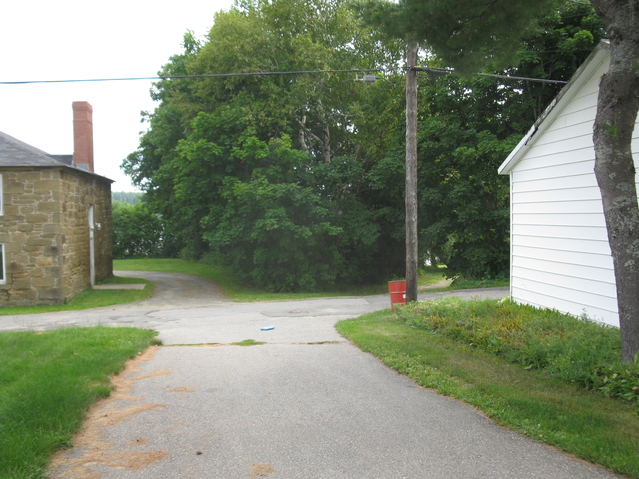
A July, 2012 photograph of the location of a most significant series of events in my life. First sight of and meeting of a number of my very first friends. The back end of my driveway (seen in bottom third of photograph) connects perpendicularly to the road running behind my 1972-7 home. And in left area of photograph is an old church hall in front of which a water pump was situated in 1972. One summer's evening in 1972, my new friend, Johnny, approached me at that water pump. Concealed by trees near photograph's centre was the home of my new friend, Michael. Michael was observing my meeting with Johnny at the water pump as he was playing cars in the sand at the top of his driveway, which is visible here to the right of the telephone pole. Michael walked up to my place on the next morning via the back of my driveway and introduced himself. White structure at right of photograph is the shed of my neighbours, the Matchetts. On the same next morning, Johnny appeared on the back road from around the rear of the Matchetts' shed, and with him was his younger brother, Rob, another new friend. That was three new friends first seen and met in 1972 in the location shown here.
After some weeks of anxiety that summer (1972) at not having any friends, I walked to a water pump in front of the old church hall behind our house and tried to operate the pump, and an amiable voice called out, "Need some help?" Johnny, a boy almost the same age as myself, and who, with his younger brother, Rob, was staying each summer with his grandparents two houses up the road from ours, was reaching out to befriend me. I reciprocated, and we introduced ourselves. We were being watched by a darker-complexioned boy three years my junior playing cars in his driveway. That younger fellow, Michael, would be my closest friend in my years in Douglastown, an outcome helped certainly by our proximity (his family's house was situated behind ours) and our year-round ability to visit each other.
Johnny and I walked up the driveway to the garage of my family's home. Using a piece of chalk, we wrote our names on the sides of the inner arch of the garage's entry. On the following sunny morning, as I was sitting on my house's back steps in wait of Johnny's arrival, Michael walked up the back of my driveway to approach me and introduce himself. A short while thereafter, Johnny appeared with Rob, and Rob and I met for the first time.
And for the number of weeks that we had together before Johnny and Rob had to go back to Ontario, Johnny, Rob, and I played in the garage, turning it into a library or a store, which Rob pretended to rob (there is a pun in this, me-thinks) as we played cops and robbers. Michael joined us for some of our play. I quickly discovered that Michael did not really like the company of Johnny, and such would not change. The result was that there were instances of two-way and sometimes three-way (i.e. inclusive of me) quarrelling. Which, I suppose, is natural for youngsters.
Johnny and Rob's grandparents, when I visited them in 1989, had a picture of Johnny and Rob in a portable rubber swimming pool sometime in the summer of 1972 after they had met me. And I was a short distance behind them in the picture. Evidently, I had joined Johnny and Rob for a swim. But I have no recollection of doing so. Immersing myself in water was not common practice for me, beyond bathing in the bathtub, and even then, I did not allow the water to rise to a level with which I was not comfortable. I became distinctly averse to water after a harrowing incident in an indoor public swimming pool at C.F.B. Chatham on February 8, 1975 (the same Saturday that instalment 22 of The Bugs Bunny/Road Runner Hour, with "The Hasty Hare", "Claws For Alarm", "Home, Tweet Home", "Terrier-Stricken", et cetera, was shown), where I was to be taught how to swim but was not advised not to jump into the swimming pool without proper initiation to underwater conditions. I panicked underwater, ingested a substantial amount of the chlorinated water, and was terrified. I fled the swimming pool area and never returned. Thereafter, whenever I was submerged in water from my chin downward, I would hyperventilate, involuntarily. Even being squirted in the face by hose water or being caught outdoors in a deluge of rain on a windy day would trigger the same frightening reaction. An induced and intense case of aqua-phobia, I guess.
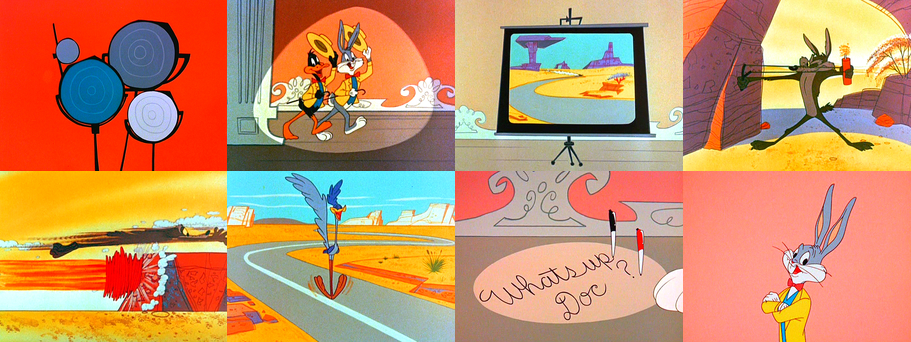
My interest in The Bugs Bunny/Road Runner Hour as shown on CBC Television, was to continue and prosper as my life proceeded into Era 2 in Douglastown.
Established in this, my life's first era, before our move from Newcastle to Douglastown, was my interest in animated cartoons. My keen regard for them. For the look of them. For the ideas in them. And the cartoons of Warner Brothers were the ones to which I was, and would continue to be, most appreciative of any opportunity to experience.
From July, 1972 through to 1975, The Bugs Bunny/Road Runner Hour would be almost the only vehicle for me to experience the Warner Brothers cartoons. I revelled at the colours on display as the CBC Television network telecast that weekly television show. The bubble gum pink backgrounds, elegant grey pillars suggesting a grand sophistication, Victorian-style theatre curtain, golden brown flooring, and bright yellow garments of characters in the stage scenes, especially the "This is it" introduction sequence, were a sumptuous feast for my young eyes. And then there were the cartoons themselves. Bugs with his bright orange carrot in hand. Orange carrots on Elmer Fudd's farm. The reddish or orangey browns of rock formations, the golden yellow sands, mossy green cacti, and blue skies of the Road Runner cartoons, against which were set the Road Runner with his bluish grey and purple plumage and the Earthy brown of the furs of Wile E. Coyote. Yellow and orange Tweety chased by red-nosed black cat Sylvester in a vast array of colourful locales. The cartoon, "Bunker Hill Bunny", with its umber shades of brown, quite apropos for the battle over territory constituting it. Purple skies of a city in mid-winter in "Putty Tat Trouble". The rather austere rosso corsa shade of red of the food processing factory in "I Gopher You". The multi-coloured chemicals in bottles, beakers, test tubes in laboratories. The stylishly cartoony depictions of buildings, railway trains, trollies, buses, and ships, places in history, places in literature, places in legend, places off of the Earth. The look of the cartoons was superlative, whilst the situations in them were consistently impressive in concept. And I was enthralled with how the cartoons were assembled in the Bugs Bunny/Road Runner episodes.
Ardour for The Bugs Bunny/Road Runner Hour and its content cartoons would be one of the major attributes of years of my second life era. My love for that television show would be consolidated in my life's Era 2, as I saw every episode in the CBC's run of Season 1 of Bugs and the Road Runner. Many of them for the first time. And growing out of my adherence to the cartoons of Warner Brothers would be my appreciations of other works.

Shortly after moving to Douglastown in 1972, I was given a wooden toy box whose outer covering was adorned with pictures of cartoon dogs with feet like those of the cartoon canines, Huckleberry Hound and Walt Disney's Pluto.
By the remit of the Victorian Order of Nurses, my mother would go on house visits to patients, and my father and I had to wait in our car, sometimes for what seemed to me to be eternities, for my mother to conclude her nursing work at each location throughout the Miramichi, most memorably in Chatham and Loggieville. We also, years earlier in Rivers, Manitoba, awaited my mother's exit from a house where she was receiving ceramics lessons, and I was the recipient of my mother's first project in that shapely art, a teddy bear lamp, which was to be in my bedroom through most of my childhood. After moving to Douglastown, I was also presented with a custom built wooden toy box with a sticky paper outer covering adorned with images of cartoon dogs with legs and feet like those of Huckleberry Hound and Walt Disney's Pluto. And to complete young Kevin McCorry's new Douglastown sleep chamber (located on the top floor of the right side of the house above the driveway) was a Captain's bed with a nursery rhyme image quilt assembled by my grandmother, and a grey plush toy dog.
I remember receiving my "booster" inoculations along with Jimmy as Mrs. Waye brought us to the Newcastle town hall on Castle Street across from the downtown square, where the needles were being administered. Jimmy wailed as his upper arm was penetrated, while I endured the painful, arm-jabbing process with nary a sound from my grimacing mouth. That would have been before the move to Douglastown. I recall on another day going with my mother and father to an office building behind the Newcastle courthouse on Prince William Street, where they were enrolling me in school. I did not understand what all of this was about, but the groundwork for a new beginning was definitely being established.
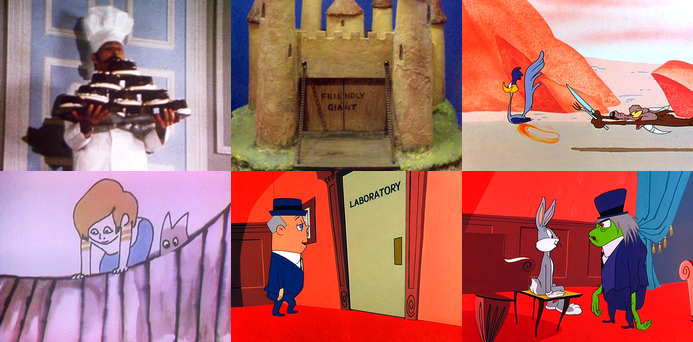
A compilation of images of television programming watched by me in Era 1: the mishap-prone baker of one of the count-the-number segments of Sesame Street; the castle of the eponymous character of CBC Television's The Friendly Giant; the Road Runner being chased by Wile E. Coyote in a cartoon in an episode of The Bugs Bunny/Road Runner Hour; the boy and dog of the 1972 television special, Dig; and Bugs Bunny's frightful experience in the domicile of one Dr. Jekyll in a cartoon that I would eventually know as "Hyde and Hare".
Since television programming and my life experiences do have a quite intricate interconnection, I am offering Television Listings For Canada's Eastern Maritime Provinces: 1966 to 1971 and Television Listings For Canada's Eastern Maritime Provinces: 1971 to 1972. Therein are television listings for specific days in this first era of my life.
As my pre-school years were reaching their end, my parents and I were settling into our new home, and I was building a number of important friendships, a transition of life eras was clearly occurring. Whereas 1966-72 was for the most part an era of seclusion from friendly fellows of my generation, in Era 2, I would be finally stepping out of my sheltered cage, as it were. Douglastown was to be the place where I could at last find acceptance and my first stable, close friendships, and it was also the location where I was most extensively influenced by what I viewed in entertainment media.

A July, 2011 photograph of the Miramichi River as seen from a road a short distance away from my 1972-7 home in Douglastown.
Era 1 had left me rather disadvantaged, my social development being significantly behind that of most other children, and my resultant shyness preventing me from promptly settling into the school setting and initially impressing my schoolmates. Era 2 would see an improvement in sociability for me, but it would not come easily or swiftly.
McCorry's Memoirs continue with McCorry's Memoirs Era 2: Where am I? In the Village of My Childhood (1972-7).
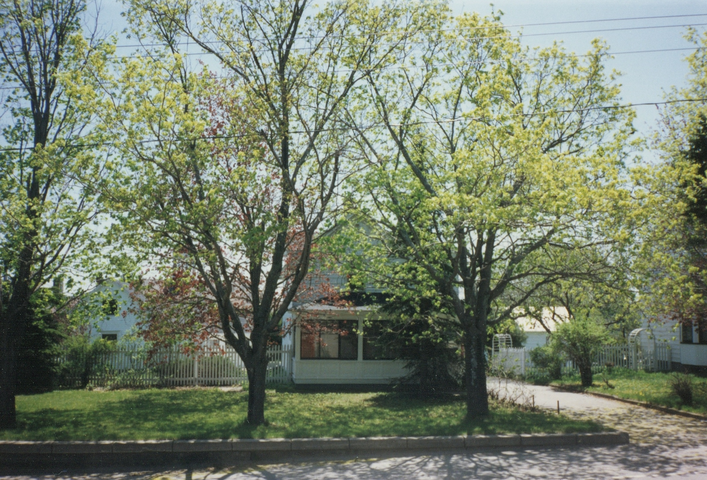
The 1972-7
McCorry homestead in Douglastown. A June, 1990 photograph.
"LITTLE ARROWS" vinyl record images (c) Decca Records
"The Solid Tin Coyote", "Bunker Hill Bunny", "Barbary-Coast Bunny", "Putty Tat Trouble", "Scrambled Aches", "Hopalong Casualty", "Hyde and Go Tweet", "Tweety's S.O.S.", "I Gopher You", "Bonanza Bunny", "Rabbit Fire", "Foxy By Proxy", "Bushy Hare", "Yankee Dood it", "Hyde and Hare", "Birds of a Father", The Bugs Bunny/Road Runner Hour, and "Ready.. Set.. Zoom!" images (c) Warner Bros.
Le roi Leo images (c) Fuji Television
Sesame Street images (c) Children's Television Workshop and Public Broadcasting Service
C.N. train at Newcastle train station image (c) Edward Barry
Yogi Bear images and image of Huckleberry Hound (c) Hanna-Barbera
A Charlie Brown Christmas images (c) United Feature Syndicate and Charles M. Schulz Creative Associates
Batman image (c) Twentieth Century Fox
Rocky and His Pals image (c) General Mills and Jay Ward Productions
The Galloping Gourmet image (c) Fremantle of Canada
Dig images (c) John and Faith Hubley Productions
Adventures in Rainbow Country, The Beachcombers, and The Friendly Giant images (c) Canadian Broadcasting Corporation
Photograph of intersection of Prince William Street and King George Highway and Nordin automobile service station photograph credited to Our Miramichi Heritage Photos Facebook group and its members
HERB ALPERT'S GREATEST HITS vinyl record cover image (c) A & M Records
OSMONDS- "CRAZY HORSES" vinyl record cover image (c) Atlantic Records
Image of Walt Disney's Pluto (c) Walt Disney Productions

Kevin McCorry's Home Page










































